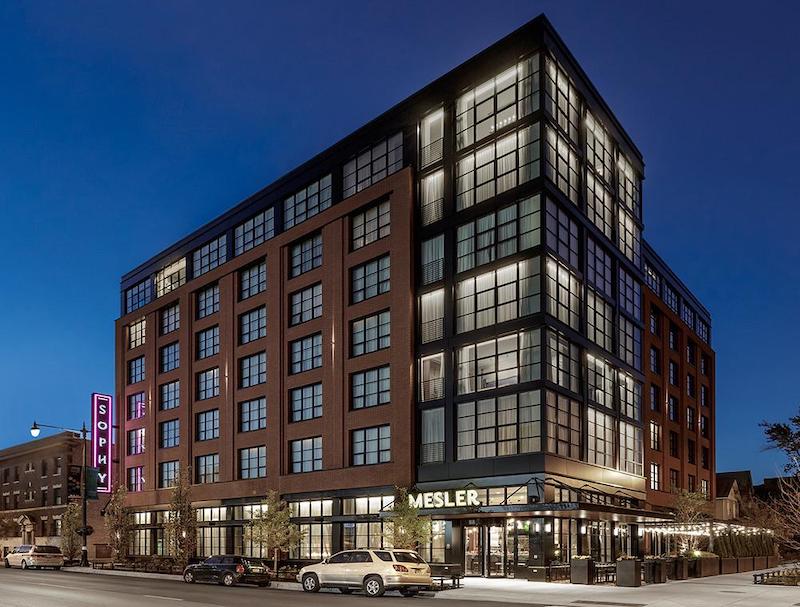The Sophy Hotel, Chicago Hyde Park’s newest boutique hotel, takes its name from the Greek word sophia, meaning knowledge and science. Completed in 2018, the seven-story, 98-guest room hotel complements the local museums, cultural attractions, and University of Chicago campus. The ground floor features 14-foot ceilings in a column-free lobby, lounge, and restaurant space; Floors two to seven include guest rooms and amenities. While the project driver during design and construction was using prefabricated, cold-formed metal framing (CFMF) wall panels, structural steel became an integral component of the building construction. This article highlights how steel was used 1) at the second-floor podium to transfer the upper levels 2) embedded within the CFMF system to create unique upper level spaces, and 3) to support exterior appendages and articulated brick veneer.
Sophy Hotel Utilizes Steel Podium Design
The second to seventh floors are guest rooms with stacked CFMF walls at the demising walls. Below the second floor, the program changes to a lobby, restaurant, and back-of-house space requiring a column-free footprint, which creates a vertical framing discontinuity. The discontinuity demands a transfer structure at the second floor.
Deep structural steel beams offer the strength and stiffness requirements for the long spans to create the open footprint. The framing generally consists of 40 in. deep, wide-flange shapes spanning up to 35 ft between perimeter steel columns and interior concrete masonry unit (CMU) core walls. The podium steel framing aligns with the CFMF wall system above. The podium framing depth is governed by serviceability limits and the ceiling height required below. To minimize global displacement and potential cracking in the gypsum wall board (GWB) sheathing on the CFMF bearing walls, total deflections at the podium level are limited to the smaller of L/1000 or 3/8 in. After accounting for a 14 ft ceiling at the ground floor and six levels of guest rooms within the 80 ft building height, a 3 ft – 8 in. space was available above the ground floor ceiling. This space is used to accommodate the steel transfer framing, mechanical ductwork, plumbing, electrical conduit, and fire protection services.
The Sophy Hotel's podium design maximized steel framing depth to accommodate beam web penetrations for the building services with the ceiling framing supported directly to the steel beam bottom flanges. While providing beam web penetrations for building services is common industry practice, in a depth-constrained podium structure, it is important to have early and on-going coordination between design and construction disciplines to avoid the need for field cutting beam web penetrations in the podium framing.
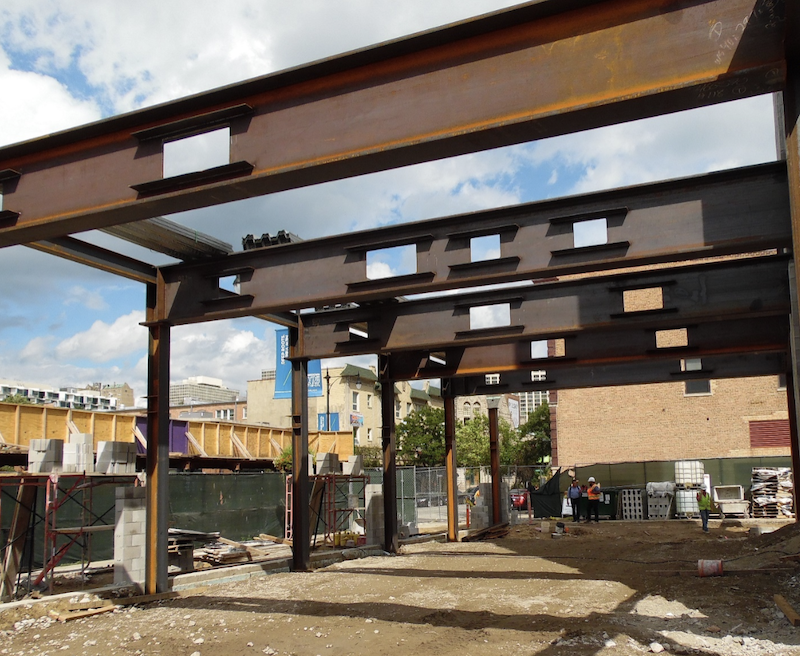 Beam web penetrations in steel podium framing.
Beam web penetrations in steel podium framing.
Upturned Framing
CFMF wall systems are most efficient when the wall panels align from the lowest level of support to the roof. Aligning wall panels requires a vertically repetitive program. Breaking up the repetitive program for open space amenities may require removing bearing walls and transferring the bearing wall load. One way to transfer the load while maintaining slab depth and without compromising ceiling heights is to provide upturned steel framing.
At the Sophy Hotel, the fitness room and laundry room are located on the second floor, each occupying a space twice the width of the typical guest room. To eliminate bearing walls on the second floor at these locations, steel columns are extended above the podium structure to support upturned, built-up plate girders. The plate girders support the bearing walls between the third floor and roof level while providing space on the second floor for the fitness room and laundry room. Built-up shapes are used to accommodate the architectural program constraints. The plate girders comprise a 6 in. wide top flange to match the width of the CFMF wall and a wider bottom flange to support the floor construction.
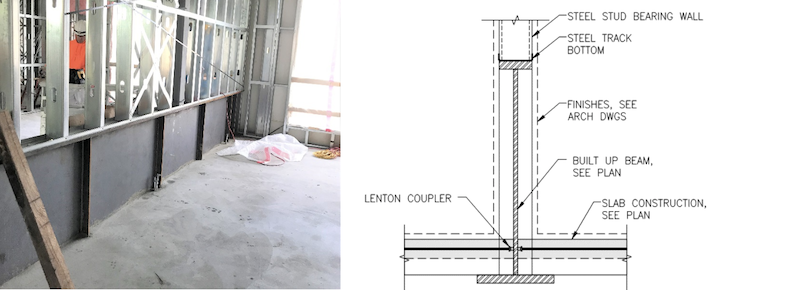 Upturned steel built-up plate girder above the fitness room.
Upturned steel built-up plate girder above the fitness room.
On a smaller scale, upturned WT5x15s span across the corridor between CFMF wall panels, with the slab construction supported on the flange, and the stem embedded within the concrete slab. This detail maximizes ceiling heights along the corridors and provides a continuous horizontal space for building services.
Steel in CFMF Walls
Structural steel framing is integrated within the CFMF wall systems to address atypical support conditions and large openings. At the sixth and seventh floors, two CFMF walls are eliminated to combine two guest rooms into an open space suite. Structural steel frames comprised of wide flange beams and HSS columns are provided in lieu of the CFMF walls to create the open space. The frame columns extend down to the podium and are fabricated into the CFMF wall panels with base plates and cap plates. In some areas, HSS headers are provided within the CFMF wall panels to span large door openings. Structural steel when required for larger spans, allows for the flexibility the program required.
Exterior Wall Support
The building envelope generally consists of articulated brick masonry veneer with large punched windows. The veneer steps around the windows creating three different vertical planes. The planes converge at vertical piers between windows. The floor construction spans from CFMF wall-to-wall without steel framing at the slab edge. To avoid a stepped slab edge and steel relieving angles, the design team balloon-framed the masonry veneer from an independent, architecturally exposed structural steel (AESS) frame at the second floor. Custom bent plate loose lintels are used above the window openings to accommodate the varying planes of masonry.
The typical AESS frame comprises a MC18x42.7, HSS20x8 and HSS6x4 knee wall spanning between CMU piers. The frame is braced at the ends and mid-span to the podium structure to resist the eccentric brick loads.
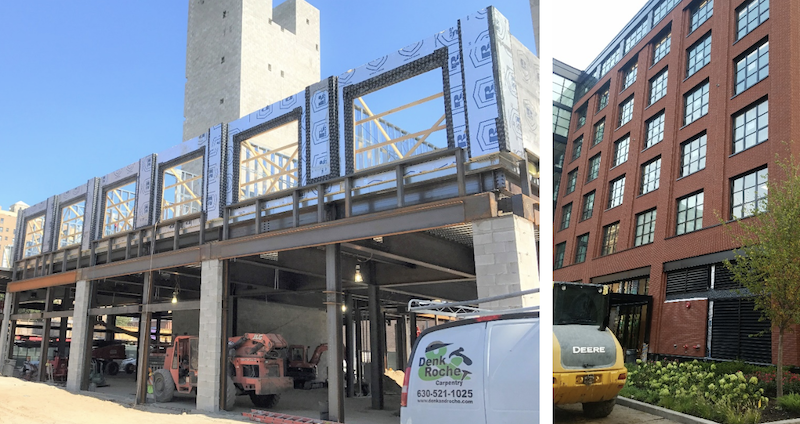 AESS structure supporting the balloon-framed brick veneer.
AESS structure supporting the balloon-framed brick veneer.
Building Appendages
The hotel features a three-story tall marquee extending from the building corner. The sign structural support includes an HSS10x6 post that extends from the second-floor steel podium to the fifth-floor, and HSS outriggers at the sign support locations. The HSS post is detailed with deck support plates and weldable rebar couplers at each floor level to drag the sign forces into the building diaphragm.
The hotel also features an 18 ft entry canopy supported at the second floor with a side-plated W40 beam and by four diagonal tie-rods pinned to HSS10x4 flat outriggers at the third floor. The outriggers are supported on HSS posts fabricated within the CFMF wall panel and extend into the third-floor slab construction with headed studs and hair pin reinforcement to drag the horizontal load into the third-floor diaphragm.
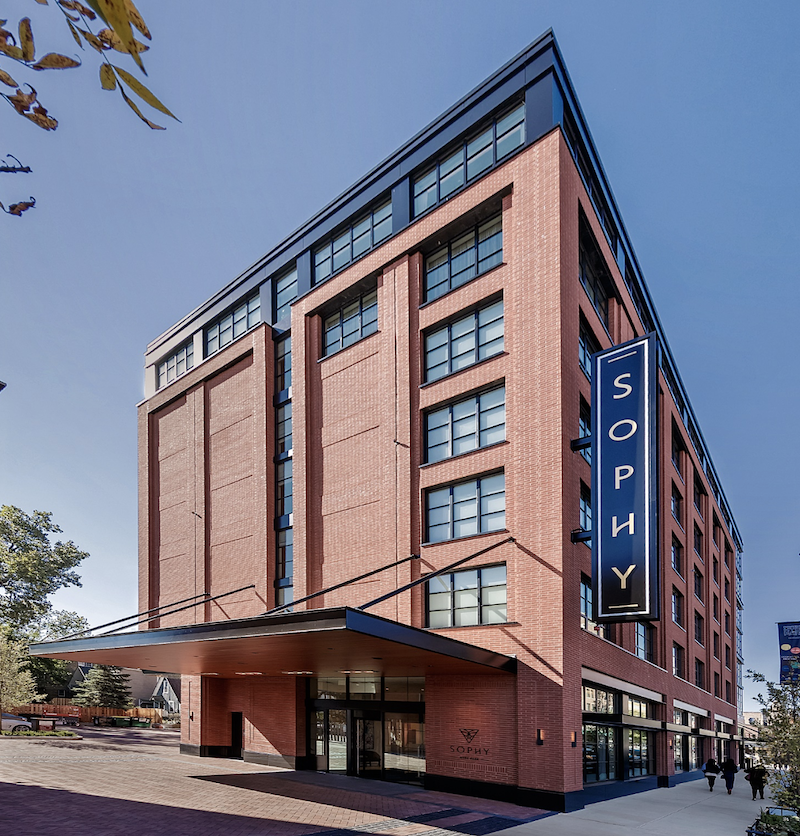 Entrance canopy structure and marquee. Photo: Mark Ballogg.
Entrance canopy structure and marquee. Photo: Mark Ballogg.
Conclusions
The structural steel framing in the construction of the Sophy Hotel is an integral component of the building structure alongside the prefabricated CFMF wall systems. It allows the building structural design to achieve the economy of repetition while creating opportunities for architectural freedom.
Related Stories
| Nov 16, 2010
CityCenter’s new Harmon Hotel targeted for demolition
MGM Resorts officials want to demolish the unopened 27-story Harmon Hotel—one of the main components of its brand new $8.5 billion CityCenter development in Las Vegas. In 2008, inspectors found structural work on the Harmon didn’t match building plans submitted to the county, with construction issues focused on improperly placed steel reinforcing bar. In January 2009, MGM scrapped the building’s 200 condo units on the upper floors and stopped the tower at 27 stories, focusing on the Harmon having just 400 hotel rooms. With the Lord Norman Foster-designed building mired in litigation, construction has since been halted on the interior, and the blue-glass tower is essentially a 27-story empty shell.
| Nov 3, 2010
Rotating atriums give Riyadh’s first Hilton an unusual twist
Goettsch Partners, in collaboration with Omrania & Associates (architect of record) and David Wrenn Interiors (interior designer), is serving as design architect for the five-star, 900-key Hilton Riyadh.
| Sep 30, 2010
Luxury hotels lead industry in green accommodations
Results from the American Hotel & Lodging Association’s 2010 Lodging Survey showed that luxury and upper-upscale hotels are most likely to feature green amenities and earn green certifications. Results were tallied from 8,800 respondents, for a very respectable 18% response rate. Questions focused on 14 green-related categories, including allergy-free rooms, water-saving programs, energy management systems, recycling programs, green certification, and green renovation.
| Sep 13, 2010
Conquering a Mountain of Construction Challenges
Brutal winter weather, shortages of materials, escalating costs, occasional visits from the local bear population-all these were joys this Building Team experienced working a new resort high up in the Sierra Nevada.
| Aug 11, 2010
Accor North America launches green hotel pilot program
Accor North America, a division of Accor Hospitality, has announced that it will pilot the Green Key Eco-Rating Program within its portfolio in the United States in 2010. Green Key is the first program of its kind to rank, certify and inspect hotels and resorts based on their commitment to sustainable "green" practices; the Accor North America pilot will involve 20 properties.
| Aug 11, 2010
CTBUH changes height criteria; Burj Dubai height increases, others decrease
The Council on Tall Buildings and Urban Habitat (CTBUH)—the international body that arbitrates on tall building height and determines the title of “The World’s Tallest Building”—has announced a change to its height criteria, as a reflection of recent developments with several super-tall buildings.
| Aug 11, 2010
Jacobs, Arup, AECOM top BD+C's ranking of the nation's 75 largest international design firms
A ranking of the Top 75 International Design Firms based on Building Design+Construction's 2009 Giants 300 survey. For more Giants 300 rankings, visit http://www.BDCnetwork.com/Giants
| Aug 11, 2010
See what $3,000 a month will get you at Chicago’s Aqua Tower
Magellan Development Group has opened three display models for the rental portion of Chicago’s highly anticipated Aqua Tower, designed by Jeanne Gang. Lease rates range from $1,498 for a studio to $3,111 for a two-bedroom unit with lake views.
| Aug 11, 2010
Architecture Billings Index flat in May, according to AIA
After a slight decline in April, the Architecture Billings Index was up a tenth of a point to 42.9 in May. As a leading economic indicator of construction activity, the ABI reflects the approximate nine to twelve month lag time between architecture billings and construction spending. Any score above 50 indicates an increase in billings.


